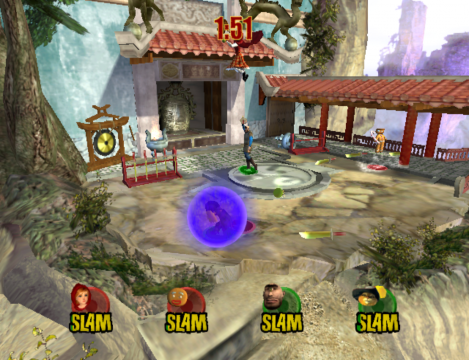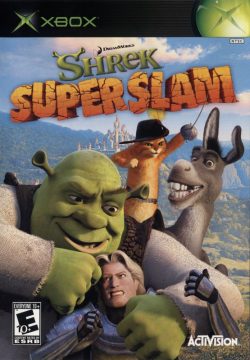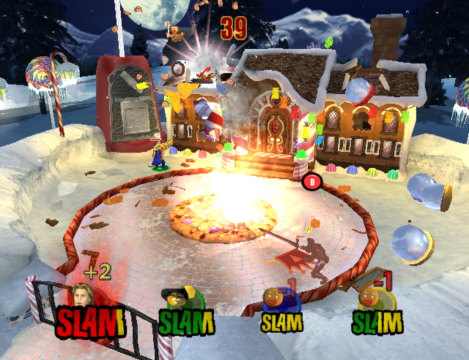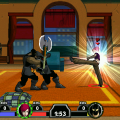Check out our podcast on Shrek SuperSlam!
In generations past, a fairly common sort of licensed game would be a take on Capcom’s often-forgotten Power Stone. These games often had a lot in common – two to four fighters allowed to move freely through a three-dimensional area, picking up and using various weapons to KO the other fighters first, and mechanics that focused more on enjoyable chaos than true depth. Shrek Superslam meets all these criteria admirably, and yet something strange happened – people started taking it seriously. Well, somewhat – it was never going to reach Evo in a hundred years, but a small presence for the game began examining it more closely. Unfortunately, whatever community there was for the game dispersed some time ago, as there simply wasn’t enough there to work with.
Still, for what is there, it’s a perfectly functional game of its kind. You’re presented with a total of 20 characters from across the Shrek universe, including a handful of original fighters. You and up to three other fighters are tasked with either getting the most points under a time limit, or depleting your opponent’s stock of lives. Interestingly, victory isn’t achieved by depleting an opponent’s health – rather, landing hits fills your character’s “slam” meter, and by filling it, you can unleash a super attack. It’s only by doing this that you can actually score points, and it makes for an interesting mechanic that forces players to remain in the fray, rather than hanging back.
There’s a multitude of techniques to make use of, although most characters remain fairly similar. Most combat is done through mixing the light and heavy attack buttons for various combinations, some of which knock back opponents farther, or break their Smash-esque bubble shield. Unlike a lot of the games that inspired it, SuperSlam is heavy on mobility options – characters can dodge roll, leap off of walls, perform air dash attacks, or guard in mid-air to drop quickly to the ground. It’s these techniques, and how they could be exploited, that made the game’s long-gone community take notice in the first place, and it remains something that helps the game stand out.
In truth, the game isn’t especially deep, but there’s an effort to make a fun game there. The game constantly spawns weapons in for extra chaos, and each time you land a slam move on a character, they go flying into the environment, creating destruction that rapidly tears apart the arena you’re fighting in. It’s a game best played at face value, as otherwise, it’s far too easy to pull the threads too far and reveal just how broken some characters can really be.
There’s an admirable attempt at single player content, at least, featuring a ‘story’ mode, with a handful of fights broken up by in-engine cutscenes. More substantially, the ‘Mega Challenge’ mode has you move across the map, fighting in both regular battles and fights with specific conditions, and this is where a majority of the game’s content can be found. Out of the many Power Stone knockoffs out there, while Capcom’s original can’t be beat, you could do far, far worse.




